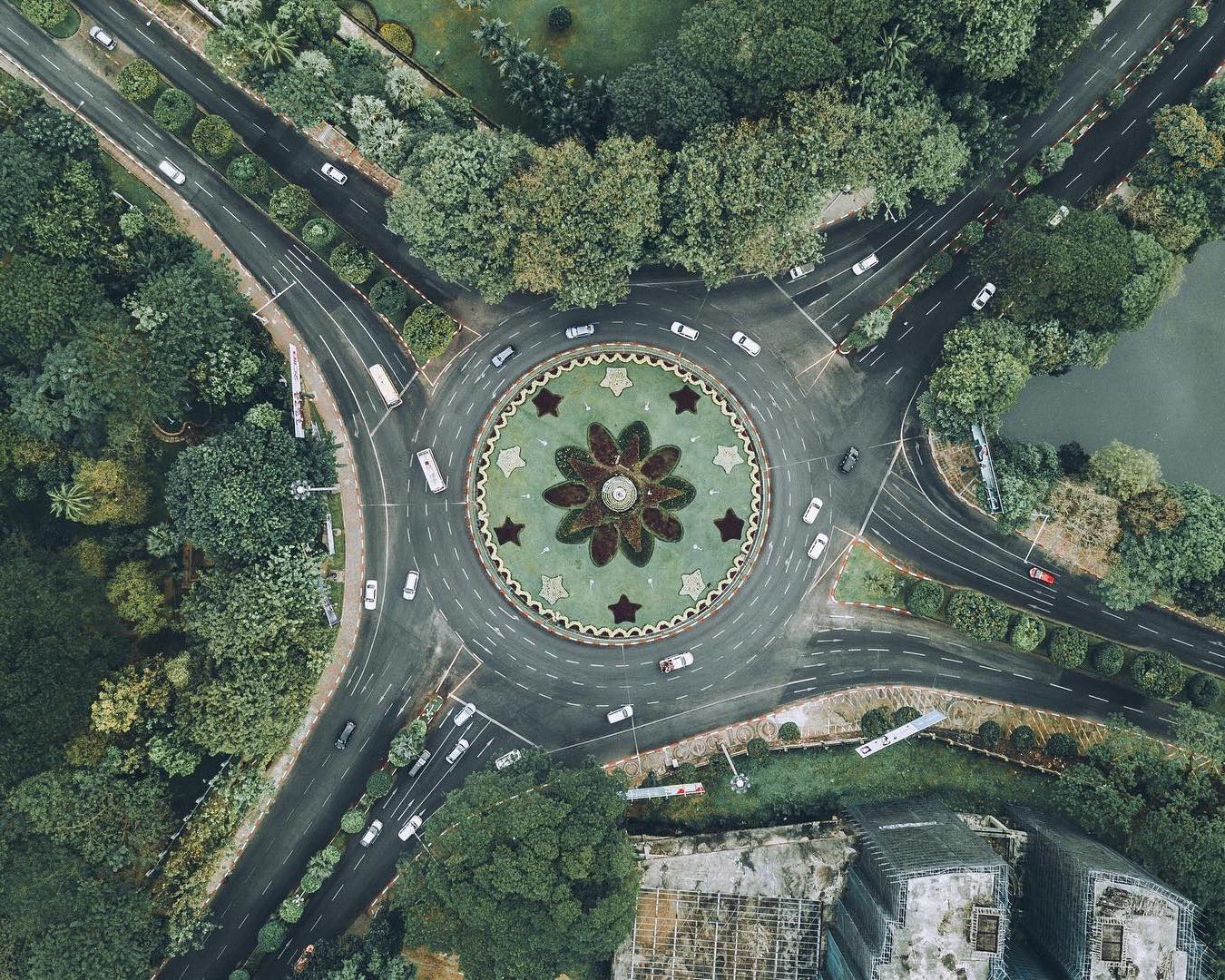Yangon may be better-known for red spit than for symmetry or skylines, but that hasn’t stopped young urban photographers from seeking its hidden beauty.
“Either you love Rangoon, or you’re wrong,” reads a caption written by Kaung Htet Zaw under an Instagram photo of Sule Pagoda that he posted in late 2016, back when he was first developing his style as an urban photographer.
The long-exposure shot captures the glowing top of the gilded pagoda poking out above the surrounding structures, as a blur of white metal and red tail lights whizzes by into the night.
“My style usually gravitates towards cinematic moments and moody color tones,” he told Coconuts.
Sharp lines, moonlit clouds, and colorful lights reflecting off dark surfaces have become the signature features of his work, which is now mostly set in Singapore, where he lives. But even though Singapore’s cyberpunk exterior is more conducive to the cinematic moodiness he prizes, he argues that Yangon is not to be ignored by urban photographers looking to hone their skills and produce art that is both beautiful and true.
“Singapore is heaven if you are into shooting architecture and abstract patterns and cityscapes, but it’s not so great for street photography,” he said. “Yangon, on the other hand, provides lots of opportunities for street photography. The chaotic traffic of the city, the juxtaposition of the old and the new in the downtown area all provide great settings for street photography.”
Kaung Htet Zaw is not alone in his belief that Yangon can be an artistic photographer’s playground. Since 2015, fellow Singapore resident Naing Wai Thaw has channeled his admiration of other people’s street photography into an art form of his own. His photography is also guided by clean lines and architectural symmetry. Although these features are not commonly associated with Yangon, he says they are all over the messy metropolis; it just takes a certain perspective to reveal them.
Using his drone, Naing Wai Thaw has captured views of Yangon that reveal order and simplicity that are invisible at the city’s surface. In one photo of a Kamayut Township roundabout, the photographer reveals a palette of greens that calls to mind Yangon’s forgotten reputation as the “Garden City of the East.”
Another photo taken from directly above Sule Pagoda shows the innumerable little universes that surround the famous monument. There’s verdant Maha Bandoola Park, a secret courtyard at the center of City Hall, and all the little side streets, each a canyon beneath rows of buildings that prevent people on the ground from remembering that there is a whole other universe on either side.
However, Naing Wai Thaw’s approach to photographing the city comes with its own challenges.
“Shooting Yangon from above is definitely a challenge for me because there’s limited amount of footage on internet for reference. Sometimes, a place looks dull and unattractive when seen from above, even though I might have expected otherwise. Thus, I can only judge the best angle I can get after flying my drone for a few minutes,” he said.
To many photographers, these few minutes signify an unacceptable risk. Myanmar is full of stories of photographers getting their drones permanently confiscated or being imprisoned for months for flying drones at the wrong place at the wrong time.
To avoid such a fate, Naing Wai Thaw offers this advice: “The regulations on drones are constantly changing here, and it is also good to do your homework before travelling to Myanmar. My advice to fellow drone photographers is that the location is to be studied first, fly from a safe distance, and avoid taking-off from places where much attention from the public is drawn.”
But using a drone is not the only way to harness the power of perspective to reveal beauty in Yangon that is unnoticeable to the naked eye. By blocking out distractions and accentuating natural lines and open spaces, the photographer behind the Instagram account Swe Stills has set out to capture minimalist scenes in a city of maximal activity.
“I like grey skies and simple backgrounds. I use clean lines. I show a lot of empty space. I tend to give my subject the attention it deserves. My style is ‘less is more,’” she told Coconuts.
(She prefers to remain anonymous, so we’ll just call her Swe Stills.)
For about two years, Swe Stills has been using the time when she’s not at her day job capturing moments that have yet to become part of Yangon’s public image. Her photos show well-known buildings or everyday objects against stark, cloudless skies or blank walls. If you saw her subjects in real life, they would be obscured by everything else happening around them. It takes a camera to unveil their minimalist appeal.
One of her photos shows a construction worker wearing a yellow hardhat and a high-visibility vest as he works beside a black tarp hanging from a construction site. He’s obviously working, but if not for the safety gear, one might think he was bent over in sorrow, or laughter, or prayer.
“People generally think of Yangon with all the gold and all the ‘blood stains,’” she said, referring to the red slobber produced by the city’s many betel-chewers. “Underneath all of that, there are a lot of different things, if you look deeply. That’s what I want to explore, and I think it’s all Yangon at heart.”



Reader Interactions